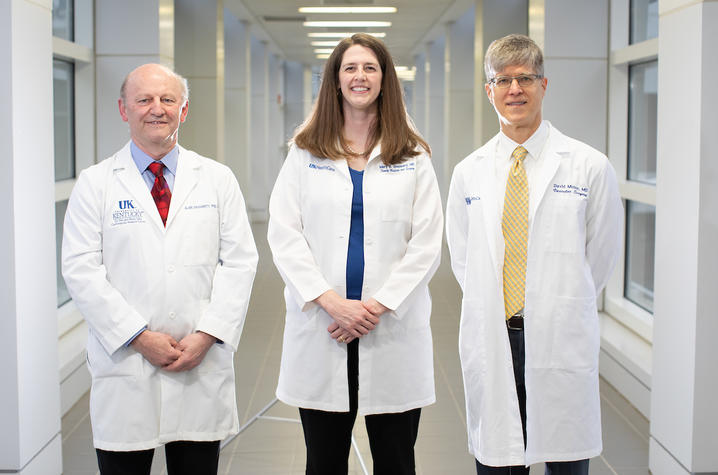UK-AARC: An Alliance Reflecting the Strength of UK’s Aortic Research
Twenty years ago, University of Kentucky researchers Alan Daugherty, PhD, DSc, and Lisa Cassis, PhD, stumbled into a research method that contributed greatly to UK’s cardiovascular research growth.
Together, they found a way to develop aortic diseases using an animal model that has now become a widely used approach to study aortic disease. This aortic disease model has been used not only to understand how the disease forms, but also as an avenue to study promising new therapies. As a result, the impact of their cardiovascular research grew and attracted high-level faculty to UK. Their group expanded, establishing a framework for the unified team they lead today.
Dr. Daugherty, professor and chair of physiology and director of the Saha Cardiovascular Research Center, and Dr. Cassis, professor of pharmacology and nutritional sciences and UK Vice President for Research, are co-principal investigators of the Aortopathy Alliance Research Center (UK-AARC). Under the College of Medicine’s Alliance Research Initiative, UK-AARC is a structured team of researchers and clinicians bringing a wide range of expertise to better understand diseases of the aorta, the body’s largest artery.
As part of the Alliance Research Initiative, UK-AARC receives important funding from the College of Medicine and Dean Robert DiPaola, as well as UK HealthCare and the UK Office of the Vice President for Research. This support enhances the team’s research on aortic diseases by promoting two-way conversations between basic scientists and clinical researchers while building collaborations across UK departments, centers, and colleges.
Examples of aortic diseases include aortic aneurysms, dissection, and rupture. These diseases can be associated with several genetic defects, such as Marfan syndrome, but also occur in many people with no known genetic basis.
There is still much to learn about aortic diseases, and some can be deadly if caught too late. Notably, the late actor John Ritter died of an aortic aneurysm in 2003. Initially, it was believed he was suffering a heart attack.
Many are treated through surgical procedures, so one of UK-AARC’s major goals is developing effective medical therapies. The Alliance Research Initiative has allowed for the bridging of unique connections across campus to solve related issues. For example, Dr. Daugherty said some patients experience ruptures at the bend of the aorta, where blood goes into the vessel. These patients describe the pain as “a knife in their back.” Unfortunately, this is a very difficult surgical area to get to, Dr. Daugherty says, because of its location behind sensitive organs and tissues. One hopeful collaboration fostered by the UK-AARC has brought researchers in engineering, radiology, cardiology, and surgery to develop a potential mode of guiding stints in an optimal, non-invasive way that could prevent leakage.
Researchers of UK-AARC are studying the multiple causes of aortic diseases. For diseases with genetic links, UK-AARC is hoping to help make testing more routine so these conditions can be caught early. Dr. Daugherty and Dr. Cassis also recently received an American Heart Association grant, which builds on research they began 20 years ago to learn how biological sex differences affect the impact of aortic diseases.
UK’s capabilities in aortic disease research continue to expand, recently demonstrated through the establishment of the Saha Aortic Center. Funded by the Saha Foundation, the center will further increase awareness of aortic diseases and promote research and education to advance clinical care. The center will be led by three UK-AARC members, director Dr. Daugherty and co-directors David Minion, MD, professor of surgery, and Mary Sheppard, MD, assistant professor of family and community medicine.
“I do think the University of Kentucky is one of the best groups around in this research area,” Dr. Daugherty said. “We are proud to have a strong presence in this field, and we plan on building something bigger and better through the newly established Aortic Center.”
To learn more about UK-AARC and other Alliance teams, visit www.med.uky.edu/alliance.
UK-AARC Alliance Team Members:
- Yasir Alsiraj, PhD, Post-Doc – Department of Pharmacology and Nutritional Sciences
- Joseph Bobadilla, MD, Professor - Department of Surgery
- Michael Bounds, MD, Assistant Professor - Department of Surgery
- Christoph Brehm, PhD, Assistant Professor – College of Engineering
- Roberto Cardarelli, DO, Professor and Chair – Department of Family and Community Medicine
- Lisa A. Cassis, PhD, Professor, VPR – Department of Pharmacology and Nutritional Sciences
- Alan Daugherty, PhD, Chair and Professor – Department of Physiology
- Eric Endean, MD, Professor – Department of Surgery
- Fred de Beer, MD, Professor – Department of Internal Medicine
- Ming Gong, MD, Professor – Department of Physiology
- Zhenheng Guo, PhD, Associate Professor – Department of Pharmacology and Nutritional Sciences
- Dong Lee, MD, Assistant Professor – Department of Surgery
- Hong S. Lu, MD, PhD, Assistant Professor – Department of Internal Medicine
- David Minion, MD, Professor – Department of Surgery
- Amanda Romesberg, DO, Assistant Professor – Department of Radiology
- Hisashi Sawada, MD, PhD, Post-Doc – Department of Physiology
- Mary Sheppard, MD, Assistant Professor – Department of Family and Community Medicine
- Preetha Shridas, PhD, Research Faculty – Department of Internal Medicine
- Vince Sorrell, MD, Professor – Department of Internal Medicine
- Venkat Subramanian, PhD, Assistant Professor – Department of Internal Medicine
- Lisa Tannock, MD, Professor – Department of Internal Medicine
- Samuel Tyagi, MD, Assistant Professor – Department of Surgery
- Nancy Webb, PhD, Professor – Department of Pharmacology and Nutritional Sciences
- Jonathan Wenk, PhD, Associate Professor – College of Engineering
- Eleftherios Xenos, MD, Professor - Department of Surgery
